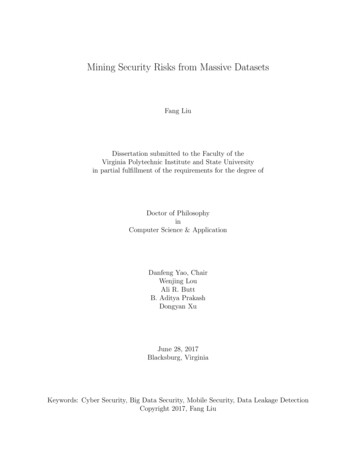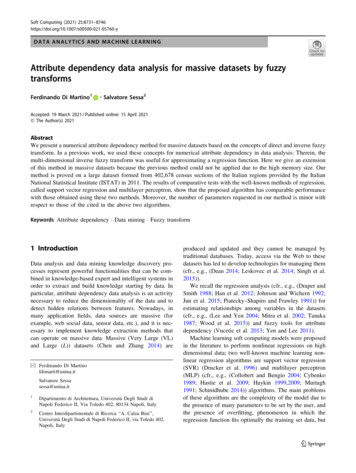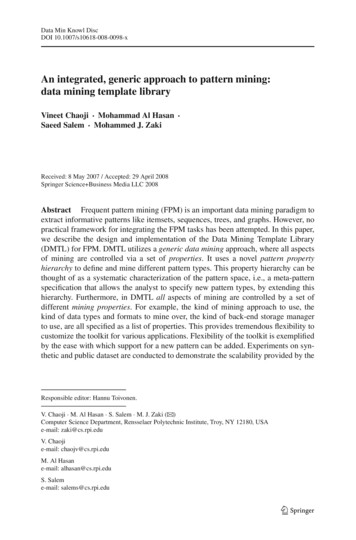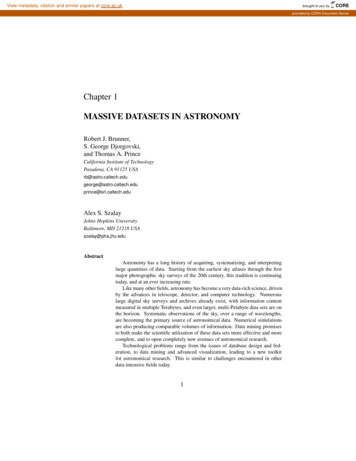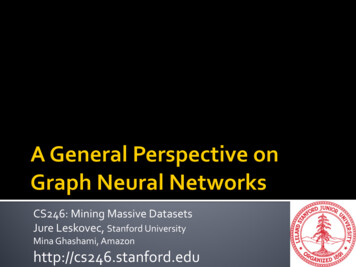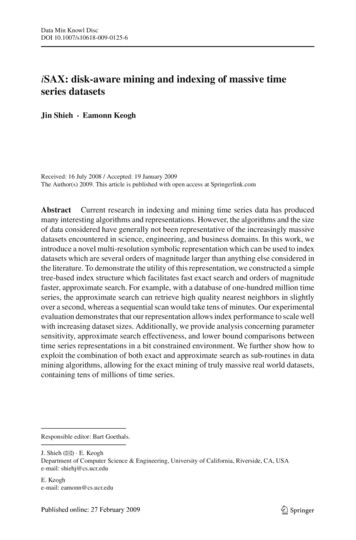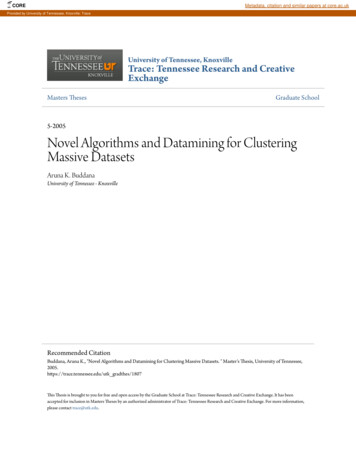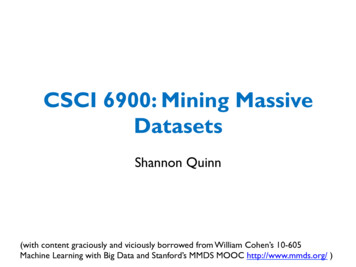
Transcription
CSCI 6900: Mining MassiveDatasetsShannon Quinn(with content graciously and viciously borrowed from William Cohen’s 10-605Machine Learning with Big Data and Stanford’s MMDS MOOC http://www.mmds.org/ )
“Big Data”
Astronomy Sloan Digital Sky Survey– New Mexico, 2000– 140TB over 10 years Large Synoptic SurveyTelescope– Chile, 2016– Will acquire 140TBevery five days11 http://www.economist.com/node/15557443
Particle Physics Large Hadron Collider (LHC)– 150 million sensors– 40 million data points / second(before filtering)– 100 collisions of interest (afterfiltering)1– Even after rejecting 199,999 ofevery 200,000collisions, generates 15PB of dataper year1,2– If all collisions were recorded, LHCwouldgenerate 500EB of data per day 900EB transmitted over IPper year31 ure-2008-001-Eng.pdf2 a.html3 341/ns525/ns537/ns705/ns827/VNI Hyperconnectivity WP.html
Biology Nucleotide sequences from120,000 species inGenBank1 European BioinformaticsInstitute (EBI)– 20PB of data (genomicdata doubles in size eachyear)2– A single sequenced humangenome can be around140GB in size2 Heterogeneous data, spreadout over many labs1 ll/455047a.html2 ll/498255a.html
Data Mining Knowledge discovery– “Big Data”– “PredictiveAnalysis”– “Data Science”
Data Scientists in demand
Why is large-scale data mining a thing? Why not use the same algorithms on larger data?
Big ML c. 1993 (Cohen, “Efficient Rule Learning”, IJCAI 1993)
Relatedpaper from1995
So in mid 1990’s . Experimental datasets were small Many commonly used algorithms wereasymptotically “slow”
Big ML c. 2001 (Banko & Brill, “Scaling to Very Very Large ”, ACL 2001)Task: distinguish pairs of easily-confused words (“affect” vs“effect”) in context
Big ML c. 2001 (Banko & Brill, “Scaling to Very Very Large ”, ACL 2001)
So in 2001 . We’re learning:– “there’s no data like more data”– For many tasks, there’s no real substitute forusing lots of data
and in 2009Eugene Wigner’s article “The Unreasonable Effectiveness of Mathematics inthe Natural Sciences” examines why so much of physics can be neatlyexplained with simple mathematical formulas such as f ma or e mc2.Meanwhile, sciences that involve human beings rather than elementaryparticles have proven more resistant to elegant mathematics. Economistssuffer from physics envy over their inability to neatly model humanbehavior. An informal, incomplete grammar of the English language runsover 1,700 pages.Perhaps when it comes to natural language processing and related fields,we’re doomed to complex theories that will never have the elegance ofphysics equations. But if that’s so, we should stop acting as if our goal is toauthor extremely elegant theories, and instead embrace complexity andmake use of the best ally we have: the unreasonable effectiveness of data.Norvig, Pereira, Halevy, “The Unreasonable Effectiveness of Data”, 2009
and in 2012Dec 2011
and in 2013
How do we use very large amounts of data?* Working with big data is not about– code optimization– learning details of todays hardware/software: GraphLab, Hadoop, parallel hardware, . Working with big data is about– Understanding the cost of what you want to do– Understanding what the tools that are available offer– Understanding how much can be accomplished withlinear or nearly-linear operations (e.g., sorting, )– Understanding how to organize your computations sothat they effectively use whatever’s fast– Understanding how to test/debug/verify with large data* according to William Cohen / Shannon Quinn
Asymptotic Analysis: Basic PrinciplesUsually we only care about positive f(n), g(n), n here f (n) O( g (n)) iff k , n0 : n n0 , f ( x) k g (n)f (n) Ω( g (n)) iff k , n0 : n n0 , f ( x) k g (n)
Asymptotic Analysis: Basic PrinciplesLess pedantically:f (n) O( g (n)) iff k , n0 : n n0 , f ( x) k g (n)f (n) Ω( g (n)) iff k , n0 : n n0 , f ( x) k g (n)Some useful rules:434O(n n ) O(n )43Only highest-order terms matter4O(3n 127n ) O(n )Leading constants don’t matter4O( log n ) O( 4 log n) O( log n)Degree of something in a log doesn’t matter
Empiricalanalysis ofcomplexity:plot run-timeon a log-logplot andmeasure theslope (usinglinearregression)
Where do asymptotics break down? When the constants are too big– or n is too small When we can’t predict what the program will do– Eg, how many iterations before convergence?Does it depend on data size or not? When there are different types of operationswith different costs– We need to understand what we should count
What do we count? Compilers don’t warn Jeff Dean. Jeff Dean warns compilers.Jeff Dean builds his code before committing it, but only tocheck for compiler and linker bugs.Jeff Dean writes directly in binary. He then writes the sourcecode as a documentation for other developers.Jeff Dean once shifted a bit so hard, it ended up on anothercomputer.When Jeff Dean has an ergonomic evaluation, it is for theprotection of his keyboard.gcc -O4 emails your code to Jeff Dean for a rewrite.When he heard that Jeff Dean's autobiography would beexclusive to the platform, Richard Stallman bought a Kindle.Jeff Dean puts his pants on one leg at a time, but if he hadmore legs, you’d realize the algorithm is actually only O(logn)
Numbers (Jeff Dean says) EveryoneShould Know
A typical CPU (not to scale)K8 core in the AMD Athlon 64 CPUHard disk(1Tb)128x bigger16x bigger256x bigger
A typical disk
Numbers (Jeff Dean says) EveryoneShould Know 10x 15x40x 100,000x
What do we count? Compilers don’t warn Jeff Dean. Jeff Dean warns compilers. . Memory access/instructions are qualitativelydifferent from disk access Seeks are qualitatively different from sequentialreads on disk Cache, disk fetches, etc work best when youstream through data sequentially Best case for data processing: stream throughthe data once in sequential order, as it’s foundon disk.
Other lessons -?** but not importantenough for this class’sassignments .
What this course *is* Overview of the current “field” of data scienceand current frameworks First-hand experience with developing algorithmsfor large datasets– Hadoop, Spark– Deployment on Amazon EC2 Emphasis on software engineering principles
What this course is *not* Introduction to programming– *Must* know Java Introduction to statistics and linear algebra– Self-evaluation on course website I will help with git and BitBucket I will help with Hadoop and Spark I will help with stats and linear algebra
Administrivia Office Hours: [TBD]Mailing list: csci6900-s15@listserv.cc.uga.eduCourse website: http://cobweb.cs.uga.edu/ squinn/mmd s15/Shannon Quinn (that’s me)– 2008: Graduated from Georgia Tech [go Jackets!]in Computer Science (B.S.)– 2010: Graduated from Carnegie Mellon inComputational Biology (M.S.)– 2014: Graduated from University of Pittsburgh inComputational Biology (Ph.D.)– Worked at IBM, Google
Administrivia Programming Language:– Java and Hadoop– Scala / Python / Java and Spark– Most assignments will not use anything else Resources:– Your desktop/laptop– GSRC Hadoop virtual cluster Getting this set up now stay tuned– Amazon Elastic Cloud Amazon EC2 [http://aws.amazon.com/ec2/] Allocation: 100 worth of time per student
Grading breakdown 40% assignments– Triweekly programming assignments Not a lot of lines of code, but it will take you time toget them right– There are 4 possible assignments, you only needto do 3 35% project– 5-week project at end of course– I strongly encourage groups of 2 25% midterm 10% student research presentations
Coding All assignments will be committed to our teampage on BitBucket– https://bitbucket.org/csci6900-s15/– Concurrent versioning system: git– I want to see progress! First two assignments: Java and Hadoop Second two assignments: Spark– Spark has Python, Scala, and Java handles
Midterm Come to lecture– (that’s not the midterm, but if you come tolecture, the midterm will be easy)
Student research presentations Each student presents once over the course ofthe semesterBasic idea:1. Pick a paper from the “big data” literature2. Prepare a 30-40 minute presentation3. Lead a 20-30 minute discussion4. ?5. Profit!
Project More later– We will add a page with pointers to datasetsand ideas for projects– Lots about scalable ML is still not wellunderstood so there’s lots of opportunities fora meaningful study
To-do listsYOU!Install gitCreate an account on BitBucketEmail me your account name so Ican add you to the BitBucketteam Check out the “Administration”repository on BitBucket, and editthe STUDENT LECTURES.mdfile to sign up for a presentationslot Check the “MAILING LIST.md”file to ensure your information iscorrect Me Post suggested papers forstudent presentations onwebsite Post updated syllabus onwebsite
Questions?
CSCI 6900: Mining Massive Datasets Shannon Quinn . - We will add a page with pointers to datasets and ideas for projects - Lots about scalable ML is still not well-understood so there's lots of opportunities for a meaningful study . To-do lists YOU! Install git
